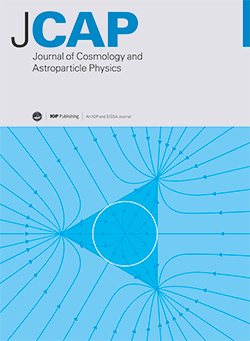The re-markable 21-cm power spectrum. Part I. Probing the Hi distribution in the post-reionization era using marked statistics
IF 5.3
2区 物理与天体物理
Q1 ASTRONOMY & ASTROPHYSICS
Journal of Cosmology and Astroparticle Physics
Pub Date : 2025-07-16
DOI:10.1088/1475-7516/2025/07/054
引用次数: 0
Abstract
The neutral hydrogen (Hi) power spectrum, measured from intensity fluctuations in the 21-cm background, offers insights into the large-scale structures (LSS) of our Universe in the post-reionization era (redshift z < 6). A significant amount of Hi is expected to reside in low- and intermediate-density environments, but the power spectrum mainly captures information from high-density regions. To more fully extract the information contained in the Hi field, we investigate the use of a marked power spectrum statistic. Here, the power spectrum is effectively re-weighted using a non-linear mark function which depends on the smoothed local density, such that low- or high-density regions are up- or down-weighted. This approach may also capture information on some higher-order statistical moments of the field. We model the Hi distribution using semi-numerical simulations and for the first time study the marked Hi power spectrum, across 1 ≤ z ≤ 5. Our analysis indicates that there is considerable evolution of the Hi field during the post-reionization era. Over a wide range of length scales (comoving wave numbers 0.05 ≤ k ≤ 1.0 Mpc-1) we expectedly find that the Hi evolves slowly at early times, but more rapidly at late times. This evolution is not well-captured by the power spectrum of the standard (unmarked) Hi field. We also study how the evolution of the Hi field depends on the chosen smoothing scale for the mark, and how this affects the marked power spectrum. We conclude that the information about the Hi content at low and intermediate densities is important for a correct and consistent analysis of Hi content and evolution based on the 21-cm background.非凡的21厘米功率谱。第一部分:用标记统计方法探讨后再电离时代的Hi分布
中性氢(Hi)功率谱,从21厘米背景的强度波动中测量,提供了对后再电离时代(红移z < 6)我们宇宙的大尺度结构(LSS)的见解。预计大量的Hi存在于低密度和中等密度的环境中,但功率谱主要捕获高密度区域的信息。为了更充分地提取Hi字段中包含的信息,我们研究了标记功率谱统计量的使用。在这里,功率谱使用依赖于平滑的局部密度的非线性标记函数有效地重新加权,从而使低或高密度区域的权重上升或下降。这种方法还可以捕获有关场的一些高阶统计矩的信息。我们利用半数值模拟模拟了Hi分布,并首次研究了在1≤z≤5范围内标记的Hi功率谱。我们的分析表明,在后再电离时代,Hi场有相当大的演变。在较宽的长度尺度范围内(共动波数0.05≤k≤1.0 Mpc-1),我们预期发现Hi在早期演化缓慢,但在后期演化更快。标准(未标记)Hi场的功率谱不能很好地捕捉到这种演变。我们还研究了Hi场的演变如何依赖于标记所选择的平滑尺度,以及这如何影响标记的功率谱。我们得出结论,低密度和中密度的Hi含量信息对于基于21 cm背景的Hi含量和演化的正确和一致的分析是重要的。
本文章由计算机程序翻译,如有差异,请以英文原文为准。
求助全文
约1分钟内获得全文
求助全文
来源期刊

Journal of Cosmology and Astroparticle Physics
地学天文-天文与天体物理
CiteScore
10.20
自引率
23.40%
发文量
632
审稿时长
1 months
期刊介绍:
Journal of Cosmology and Astroparticle Physics (JCAP) encompasses theoretical, observational and experimental areas as well as computation and simulation. The journal covers the latest developments in the theory of all fundamental interactions and their cosmological implications (e.g. M-theory and cosmology, brane cosmology). JCAP''s coverage also includes topics such as formation, dynamics and clustering of galaxies, pre-galactic star formation, x-ray astronomy, radio astronomy, gravitational lensing, active galactic nuclei, intergalactic and interstellar matter.
 求助内容:
求助内容: 应助结果提醒方式:
应助结果提醒方式:


